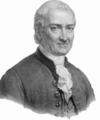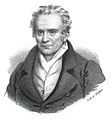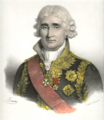List of presidents of the Senate of France facts for kids
Quick facts for kids President of the French Senate |
|
|---|---|
Logo of the French Senate
|
|
| Senate of France | |
| Member of | French Parliament |
| Residence | Petit Luxembourg |
| Term length | 3 years,
renewable
|
| Formation | 28 October 1795 |
| First holder | Claude-Antoine Rudel |
| Succession | 1st |
The President of the French Senate is a very important leader in France. The Senate is like one part of France's Parliament, which is where laws are made. The President of the Senate leads this group.
France has had different types of Senates throughout its history. Sometimes they were just advisory groups, like a council that gives advice. Other times, they were more like a law-making body. The idea of having an "upper house" (a second group of lawmakers) started in France way back in 1795. Over the years, the name and exact role of this group changed, but it always had a leader, or "President." In 1959, with a new constitution, the name "Senate" was brought back.
Contents
What the President of the Senate Does
The President of the Senate has two main jobs. First, they lead the Senate meetings and make sure everything runs smoothly. They are like the referee for the Senate.
Second, and this is a big one, if the President of France cannot do their job (for example, if they resign or pass away), the President of the Senate steps in. They become the Acting President of France until a new President can be elected. This has happened twice in history.
A man named Alain Poher, who was President of the Senate, became Acting President of France two times.
- The first time was in 1969, after President Charles de Gaulle resigned. Alain Poher was Acting President for about two months.
- The second time was in 1974, after President Georges Pompidou passed away. Alain Poher again stepped in as Acting President for about two months.
Leaders of France's Upper Houses
Over the years, France's "upper house" (the Senate or similar groups) has had many different leaders. Here's a look at some of the key periods and their Presidents.
Early Leaders (1795–1848)
France's first upper house was called the Council of Ancients (1795–1799). Later, during the First Empire (1804–1814), it was known as the Sénat conservateur. During the Bourbon Restoration (1814–1830) and the July Monarchy (1830–1848), the upper house was called the Chamber of Peers. Many different people led these groups over the years.
- The very first President of the Council of Ancients was Claude-Antoine Rudel, who took office on October 28, 1795.
- The last President of the Chamber of Peers was Étienne-Denis Pasquier, who served until February 24, 1848.
Second Empire (1852–1870)
During the Second Empire, the upper house was again called the Senate.
| Portrait | Name | Took office | Left office | Political party |
|---|---|---|---|---|
 |
Jérôme Bonaparte | 28 January 1852 | 30 November 1852 | Bonapartist |
 |
Raymond-Theodore Troplong | 30 December 1852 | 1 March 1869 | Bonapartist |
 |
Adrien Marie Devienne | 3 March 1869 | 20 July 1869 | Bonapartist |
 |
Eugène Rouher | 20 July 1869 | 4 September 1870 | Bonapartist |
Third Republic (1870–1940)
The Third Republic also had a Senate.
| Portrait | Name | Took office | Left office | Political party |
|---|---|---|---|---|
 |
Gaston Audiffret-Pasquier | 13 March 1876 | 15 January 1879 | Conservative |
 |
Louis Martel | 15 January 1879 | 25 May 1880 | Conservative |
 |
Léon Say | 25 May 1880 | 2 February 1882 | Republican |
 |
Philippe Le Royer | 2 February 1882 | 24 February 1893 | Republican |
 |
Jules Ferry | 24 February 1893 | 17 March 1893 | Left Republican |
 |
Paul-Armand Challemel-Lacour | 27 March 1893 | 16 January 1896 | Opportunist Republican |
 |
Émile Loubet | 16 January 1896 | 18 February 1899 | Left Republican |
 |
Armand Fallières | 3 March 1899 | 17 January 1906 | Democratic Republican Alliance |
 |
Antonin Dubost | 16 February 1906 | 14 January 1920 | Democratic Republican Alliance |
 |
Léon Bourgeois | 14 January 1920 | 22 February 1923 | Radical |
 |
Gaston Doumergue | 22 February 1923 | 13 June 1924 | Radical |
 |
Justin de Selves | 19 June 1924 | 9 January 1927 | Radical |
 |
Paul Doumer | 14 January 1927 | 13 May 1931 | Radical |
 |
Albert Lebrun | 11 June 1931 | 10 May 1932 | Democratic Alliance |
 |
Jules Jeanneney | 3 June 1932 | 9 July 1940 | Radical |
Fourth Republic (1946–1958)
In the Fourth Republic, the upper house was called the Council of the Republic.
Political party
MRP Radical
| Portrait | Name | Took office | Left office | Political party | |
|---|---|---|---|---|---|
 |
Auguste Champetier de Ribes | 27 December 1946 | 6 March 1947 | MRP | |
 |
Gaston Monnerville | 18 March 1947 | 2 October 1958 | Radical | |
Fifth Republic (1958–present)
Since 1958, France has been in its Fifth Republic, and the upper house is once again called the Senate.
Political party
Radical CD; CDS; FD RPR; UMP; LR PS
| Portrait | Name | Took office | Left office | Political party | |
|---|---|---|---|---|---|
 |
Gaston Monnerville | 9 December 1958 | 2 October 1968 | Radical | |
 |
Alain Poher | 3 October 1968 | 1 October 1992 | CD (until 1976) CDS (from 1976; within the UDF from 1978) |
|
 |
René Monory | 2 October 1992 | 1 October 1998 | CDS (until 1995) FD (from 1995; within the UDF) |
|
 |
Christian Poncelet | 2 October 1998 | 30 September 2008 | RPR (until 2002) UMP (from 2002) |
|
 |
Gérard Larcher | 1 October 2008 | 30 September 2011 | UMP | |
 |
Jean-Pierre Bel | 1 October 2011 | 30 September 2014 | PS | |
 |
Gérard Larcher | 1 October 2014 | Incumbent | UMP (until 2015) LR (since 2015) |
|
See also
- Senate (France)
- Council of Ancients (France)
- Council of the Republic (France)
- Chamber of Peers (France)
- President of the Senate (France)
Images for kids


